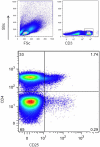FOXP3 expression is upregulated in CD4T cells in progressive HIV-1 infection and is a marker of disease severity
- PMID: 20668701
- PMCID: PMC2909259
- DOI: 10.1371/journal.pone.0011762
FOXP3 expression is upregulated in CD4T cells in progressive HIV-1 infection and is a marker of disease severity
Abstract
Background: Understanding the role of different classes of T cells during HIV infection is critical to determining which responses correlate with protective immunity. To date, it is unclear whether alterations in regulatory T cell (Treg) function are contributory to progression of HIV infection.
Methodology: FOXP3 expression was measured by both qRT-PCR and by flow cytometry in HIV-infected individuals and uninfected controls together with expression of CD25, GITR and CTLA-4. Cultured peripheral blood mononuclear cells were stimulated with anti-CD3 and cell proliferation was assessed by CFSE dilution.
Principal findings: HIV infected individuals had significantly higher frequencies of CD4(+)FOXP3(+) T cells (median of 8.11%; range 1.33%-26.27%) than healthy controls (median 3.72%; range 1.3-7.5%; P = 0.002), despite having lower absolute counts of CD4(+)FOXP3(+) T cells. There was a significant positive correlation between the frequency of CD4(+)FOXP3(+) T cells and viral load (rho = 0.593 P = 0.003) and a significant negative correlation with CD4 count (rho = -0.423 P = 0.044). 48% of our patients had CD4 counts below 200 cells/microl and these patients showed a marked elevation of FOXP3 percentage (median 10% range 4.07%-26.27%). Assessing the mechanism of increased FOXP3 frequency, we found that the high FOXP3 levels noted in HIV infected individuals dropped rapidly in unstimulated culture conditions but could be restimulated by T cell receptor stimulation. This suggests that the high FOXP3 expression in HIV infected patients is likely due to FOXP3 upregulation by individual CD4(+) T cells following antigenic or other stimulation.
Conclusions/significance: FOXP3 expression in the CD4(+) T cell population is a marker of severity of HIV infection and a potential prognostic marker of disease progression.
Conflict of interest statement
Figures




Similar articles
-
The prevalence of FOXP3+ regulatory T-cells in peripheral blood of patients with NSCLC.Cancer Biother Radiopharm. 2009 Jun;24(3):357-67. doi: 10.1089/cbr.2008.0612. Cancer Biother Radiopharm. 2009. PMID: 19538059
-
HIV-1 binding to CD4 on CD4+CD25+ regulatory T cells enhances their suppressive function and induces them to home to, and accumulate in, peripheral and mucosal lymphoid tissues: an additional mechanism of immunosuppression.Int Immunol. 2009 Mar;21(3):283-94. doi: 10.1093/intimm/dxn146. Epub 2009 Feb 10. Int Immunol. 2009. PMID: 19208751 Free PMC article.
-
CD4+ and CD8+ T cells expressing FoxP3 in HIV-infected patients are phenotypically distinct and influenced by disease severity and antiretroviral therapy.J Acquir Immune Defic Syndr. 2009 Jul 1;51(3):248-57. doi: 10.1097/QAI.0b013e3181a74fad. J Acquir Immune Defic Syndr. 2009. PMID: 19363449
-
Activation-induced FOXP3 in human T effector cells does not suppress proliferation or cytokine production.Int Immunol. 2007 Apr;19(4):345-54. doi: 10.1093/intimm/dxm014. Epub 2007 Feb 27. Int Immunol. 2007. PMID: 17329235
-
Low expressions of PD-L1 and CTLA-4 by induced CD4+CD25+ Foxp3+ Tregs in patients with SLE and their correlation with the disease activity.Cytokine. 2020 Sep;133:155119. doi: 10.1016/j.cyto.2020.155119. Epub 2020 Jun 11. Cytokine. 2020. PMID: 32535334
Cited by
-
Differentiating Immune Cell Targets in Gut-Associated Lymphoid Tissue for HIV Cure.AIDS Res Hum Retroviruses. 2017 Nov;33(S1):S40-S58. doi: 10.1089/AID.2017.0153. AIDS Res Hum Retroviruses. 2017. PMID: 28882067 Free PMC article. Review.
-
Crosstalk of Microorganisms and Immune Responses in Autoimmune Neuroinflammation: A Focus on Regulatory T Cells.Front Immunol. 2021 Oct 7;12:747143. doi: 10.3389/fimmu.2021.747143. eCollection 2021. Front Immunol. 2021. PMID: 34691057 Free PMC article. Review.
-
Induction of Multiple Immune Regulatory Pathways with Differential Impact in HCV/HIV Coinfection.Front Immunol. 2014 Jul 8;5:265. doi: 10.3389/fimmu.2014.00265. eCollection 2014. Front Immunol. 2014. PMID: 25071758 Free PMC article.
-
Targeting human inducible regulatory T cells (Tr1) in patients with cancer: blocking of adenosine-prostaglandin E₂ cooperation.Expert Opin Biol Ther. 2011 Sep;11(9):1203-14. doi: 10.1517/14712598.2011.581225. Epub 2011 Jun 26. Expert Opin Biol Ther. 2011. PMID: 21702720 Free PMC article. Review.
-
Reciprocal relationship of T regulatory cells and monocytic myeloid-derived suppressor cells in LP-BM5 murine retrovirus-induced immunodeficiency.J Gen Virol. 2016 Feb;97(2):509-522. doi: 10.1099/jgv.0.000260. Epub 2015 Aug 6. J Gen Virol. 2016. PMID: 26253145 Free PMC article.
References
-
- Savarino A, Bottarel F, Malavasi F, Dianzani U. Role of CD38 in HIV-1 infection: an epiphenomenon of T-cell activation or an active player in virus/host interactions? AIDS. 2000;14:1079–1089. - PubMed
-
- Sousa AE, Carneiro J, Meier-Schellersheim M, Grossman Z, Victorino RM. CD4 T cell depletion is linked directly to immune activation in the pathogenesis of HIV-1 and HIV-2 but only indirectly to the viral load. J Immunol. 2002;169:3400–3406. - PubMed
-
- Sakaguchi S, Sakaguchi N, Asano M, Itoh M, Toda M. Immunologic self-tolerance maintained by activated T cells expressing IL-2 receptor alpha-chains (CD25). Breakdown of a single mechanism of self-tolerance causes various autoimmune diseases. J Immunol. 1995;155:1151–1164. - PubMed
-
- Apoil PA, Puissant B, Roubinet F, Abbal M, Massip P, et al. FOXP3 mRNA levels are decreased in peripheral blood CD4+ lymphocytes from HIV-positive patients. J Acquir Immune Defic Syndr. 2005;39:381–385. - PubMed
Publication types
MeSH terms
Substances
Grants and funding
LinkOut - more resources
Full Text Sources
Medical
Research Materials

